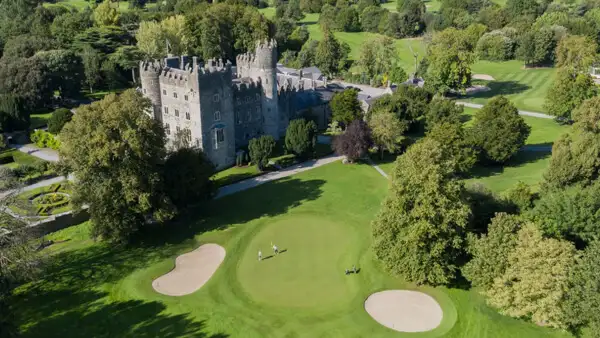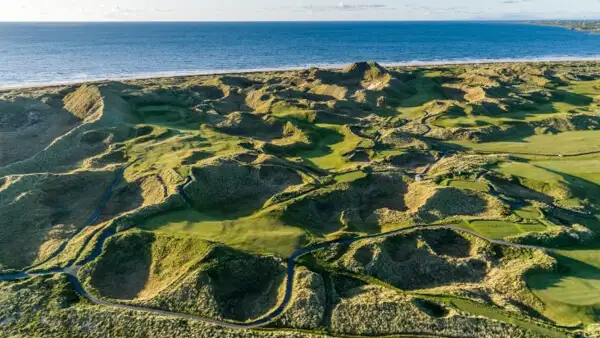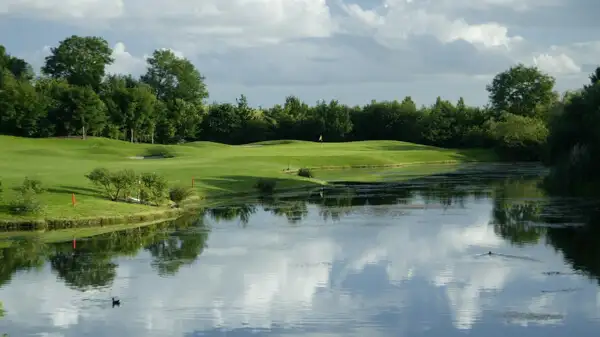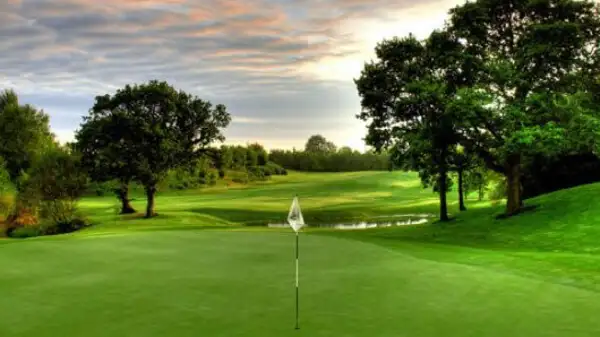Thinking about a golf holiday in Ireland? Very good idea, I can only recommend it! The Irish island is a dream destination for golfers.
Page Contents (click line to jump the text)

Intro
There are about 400 golf courses with a population of 5 million Irish and another 1.8 million Northern Irish. For comparison: Germany has about 700 golf courses with a population of 85 million. In other words, the density of golf courses per inhabitant is much higher than in Germany.
To put it less statistically: There are plenty of golf courses practically everywhere on the island and it is much less busy there.
Another thing: On the Irish island you will find 58 links courses and thus a little over a third of the links golf courses in the world!
And the highlight: many beautiful golf courses are located directly by the sea, either in the dunes on the beach or above the cliffs – it couldn’t be more beautiful!
Well, are you starting to get that holiday feeling? That’s good!
Of course, you can book an organised golf trip with a German tour operator. But you don’t have to, because you can easily organise your trip to Ireland yourself.
In the following, I’ll give you 15 good tips to help you plan your trip.
We know the island well, by the way, because we live here in Ireland, just south of Dublin (second home). We have travelled around Ireland a lot over the years and also golfed.
But now let’s get to your travel tips:
Tip 1: Weather and climate
Ireland has a mild climate all year round. In summer it gets warm but rarely hot and in winter it gets cool but rarely cold. There can be some night frost on the mountains, but practically never on the coasts. In summer you can expect 20-15 degrees Celsius, in winter 5-10 degrees,
8-16 degrees in spring and autumn. It rains more in winter than in summer and more on the west coast than on the east coast. There can always be wind on the island, sometimes stormy in autumn and winter. If you know the weather in northern Germany, then you know roughly what Ireland is like.

Tip 2: Best time to travel
You’ll have the least rain in the summer months and the fewest tourists in the winter months, although the crowds are manageable compared to typical Mediterranean countries. The transitional periods are a good compromise: pleasantly mild temperatures for playing golf, and few people.
My favourites are therefore April-May and September-October. But you have a choice. Since the courses on the coast are frost-free, they are open all year round – and we have also had 12 degrees and sun in December.
Tip 3: Clothing and equipment
It’s likely to be windy and there’s a chance of rain. Quick-drying golf clothes made of synthetic fibres are therefore better than cotton. Shoes may be waterproof, especially in winter, and a second pair is no mistake.
A cap is good in the sun, but can fly off in the wind. In the cooler months, Irish golfers are therefore seen wearing caps (ski caps). A scarf or bandana makes sense and a rain jacket may go in your golf bag. In summer, don’t forget your sunglasses, and also sun cream – there are sunny days too!
Tip 4: Money, ID, language
Ireland (Republic) is a member of the EU, the currency is the Euro. Northern Ireland is part of Great Britain and has the pound. You need your passport to enter the country. Don’t forget your driving licence, your home driving licence is sufficient. You can also bring your golf card, although many clubs do not require it.
The language is English throughout the island. Gaelic (Irish) is spoken in some regions, but everyone speaks English. If your school English is a bit rusty, it doesn’t matter. The Irish are generally friendly and helpful, so you can get by with a little English.
Tip 5: Electrical devices
Your mobile phone will also have reception here, but make sure that you have activated international roaming with your network provider. The household mains supply is 230 volts, like in Germany, but Ireland has the English sockets. You will therefore need a travel adapter for England/UK.
Tip 6: Flights and golf luggage
There are several airlines that offer direct flights to Dublin from several German airports. You can always take golf luggage with you as sports luggage. However, you will need a golf travel bag that will not break open even if it is handled roughly.
I recommend a model with wheels, because you will have to walk a bit with it at the airport. Personally, I have often travelled with a small golf travel bag with half a set of golf clubs. It’s handy, very easy to carry and was enough for me.
Tip: On links courses, long irons often work better than drivers and woods because the ball stays flatter under the wind and rolls out longer. In summer, you should book flights well in advance, otherwise it can get expensive.

Tip 7: Car hire and driving on the left
Of course, you can book a golf resort, go there by public transport and stay there. But it also makes a lot of sense to combine your holiday with a nice round trip and then you can’t avoid a rental car.
There are several car rental companies at Dublin Airport. In summer, you should book well in advance, otherwise it will be expensive at short notice. A small car is better than a big one because the country roads are often extremely narrow.
If you are not used to driving on the left, then a car with automatic transmission will help you. You sit on the right and change gears with your left hand. Forget maps, you need a sat nav or your smartphone. Download the Google Maps app, get a long charging cable and a power bank and a holder that you can easily attach to any car, for example with a suction cup.
Of course, you can also travel with your own car and save on flights and rental cars, but take your time to calculate the time and money required – it’s only worth it for really long stays.
Tip 8: Round trip or day tours
Most people underestimate the driving times in Ireland. Most of the time you’ll be driving in unfamiliar left-hand traffic on narrow country roads where the 80 km/h speed limit seems like pure speeding.
The travelling speed in Ireland is very low, so are the daily distances. Allow 100-200 kilometres, depending on how much golf you want to play that day.
So you can do a round trip where you drive a little and play a lot, or you can drive a little more and only play a round every other day.
Alternatively, you can choose a nice region, rent a place there for a week and then go on day trips to explore the golf courses in the area. This can be a good alternative for the winter. If the weather doesn’t cooperate, you don’t have to check out in the morning, but can wait and start later.
Tip 9: Book golf package deals or individually
The Irish love package deals. Many golf resorts offer green fees on one or more courses, one or more overnight stays and full board or half board as a package. I will certainly write a separate article on package providers. Until then, you can easily research them yourself on the internet. Of course, you can save money and maybe you have already found your location with day tour golf courses in the area.
Tip 10: Links Courses or Parkland Courses
Parkland courses often correspond to the golf courses we know in Germany. Around 1900, links courses were usually built into the dune landscape requiring sandy beaches. The classic links courses were laid out with shovels and wheelbarrows, follow the course of the terrain and are very natural.
Modern links courses are elaborately planned and laid out with machines. In all cases, the ground is sandy, often hard, and with fast greens. The location directly on the sea is usually beautiful and it can always be windy. Links courses are unusual to play at first, but they are a lot of fun and something you don’t have at home. Enjoy the sea, you are on an island!
Tip 11: Which region in Ireland – where to go
Many tourists travel directly to the west coast to drive the Wild Atlantic Way. That is also really beautiful. But as a golfer you will also find many great courses in the northwest of Ireland, in Northern Ireland, on the east coast and in the south. It doesn’t have to be just the Wild Atlantic Way. In high summer, it’s less touristy in the northwest or on the south coast.
You can also play wonderful golf inland. But then on parkland courses, because links courses are only on the coast. Tip: There are wonderful castle hotels with a golf course – also a great idea!

Tip 12: Booking accommodation
In summer, you should book your accommodation well in advance, otherwise it can be scarce or expensive, or usually both. Booking platforms like booking.com or airbnb work well in Ireland and are widely used.
The classic accommodation is the B&B, but there are also many golf resorts with hotels included. Only purse strings limit the imagination and options.
Tip 13: Sightseeing
Yes, you can just golf in Ireland…. but it’s also nice to take in some impressions of the country and culture.
There are many beautiful castles and medieval monasteries to visit, nice colourful towns, nice exhibitions and, especially in summer, festivals of all kinds: food, music, art, craft,…just google what’s going on in your region and include it in your trip.
Many pubs offer live music – this is also part of Irish culture.

Tip 14: Eating and drinking
Eating and drinking is also part of Irish culture. You can leave your diet at home, here we eat hearty!
Try a few games of Irish dishes. Local fish and seafood, the best beef steaks and lamb stews and cottage pies – all delicious. Even the dessert!
Guinness tastes even better here than at home and there are mildly spicy Irish whiskeys of the finest quality. The only thing you don’t have to order is wine, which doesn’t grow here.
Tip 15: Finish your trip in Dublin
You can visit Dublin on the first day – and then carry all the souvenirs around with you, or you can do the last night in Dublin, which I highly recommend. Dublin is a special and interesting city, right on the sea, divided by a river and with many sights. Whether you like museums, Guinness Brewery, daytime strolling or nightlife, there’s a great end to the trip for everyone!
Conclusion
Ireland is a truly beautiful island even for non-golfers. For golfers, Ireland is a paradise!
Golfing right by the sea, long white sandy beaches and high spectacular cliffs, the wind plays with you – and you with it. Deep sand bunkers and arrow-quick greens on fantastic links golf courses, embedded in a wonderful dune landscape – well, that’s about as good as it gets, isn’t it?
Add to that the relaxed friendliness of the Irish, good food and drink and a rich and interesting culture.
You can easily plan your golf holiday in Ireland yourself and I hope that my tips will help you.
Have fun on the Emerald Isle!
More interesting articles for you
GOLF HOLIDAYS IN THE “GARDEN” OF WICKLOW, AND THE SUNNY SOUTH EAST OF IRELAND
11 GREAT GOLF COURSES ON THE SOUTHERN WILD ATLANTIC WAY
GOLF HOLIDAYS IN IRELAND – IN THE WINTER HALF YEAR – 12 HOT TIPS ON THE SOUTH EAST COAST!
STUNNING GOLF RESORTS IN IRISH CASTLES, MANOR HOUSES AND ESTATES
Cover photo credit: Photo by Willdwind / William Martret on Unsplash